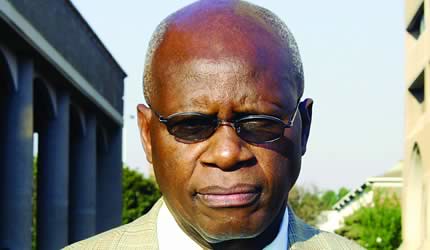
Republic of Zimbabwe Minister of Justice and Legal Affairs Patrick Chinamasa. Zimbabwe has recently declined funding for the upcoming elections from the United Nations., a photo by Pan-African News Wire File Photos on Flickr.
GDP projected to grow by 6pc
November 5, 2013
Golden Sibanda Senior Business Reporter
Zimbabwe Herald
ZIMBABWE’S gross domestic product is projected to grow by 6,1 percent next year to US$15,5 billion largely driven by growth in the mining, Finance and Economic Development Minister Patrick Chinamasa has said. Addressing parliamentarians during a pre-Budget seminar in Victoria Falls on Saturday, Minister Chinamasa said on the basis of the projected growth rate, revenue was anticipated to increase from US$3,7 billion this year (revised downward from US$3,8 billion) to US$4,4 billion. Treasury expects to spend US$4,4 billion as budgeted in line with the cash budgeting principle. Capital expenditure is set to be increased from 14,7 percent this year to 18 percent next year.
Minister Chinamasa will, however, soon start putting emphasis on off-Budget financing of capital projects through Build, Operate and Transfer and Public Private Partnership initiatives.
In 2014 current expenditure is expected to maintain pressure on the fiscus at US$3,6 billion with US$1,9 billion of that amount anticipated to be spent on salaries and wages for civil servants.
Minister Chinamasa said while annual inflation has fallen from 2,51 percent in January to 0,86 percent in September, it is expected to rise marginally to 1,5 percent next year.
“In terms of key projections the economy is projected to grow from 3,4 percent to 6,1 percent and a nominal gross domestic product of US$15,5 billion,” Minister Chinamasa said.
The economy is projected to grow at an average 7 percent until 2018 after Government said it will work hard to address all challenges including shortage of funding.
“The 2014 macro-economic framework takes into account the new series of national statistics following the completion of a poverty, income and expenditure survey results of 2012,” he said.
The chairperson of the University of Zimbabwe Economics Department, Dr Pheneas Kadenge, commended Government for adopting sound macro-economic policies saying all that is required to ensure growth in 2014 has been captured in Minister Chinamasa 2014 Budget framework.
However, he said that the performance of the 2014 National Budget will depend on the extent to which the minister’s projections were realistic.
“The figures that are being suggested for the growth of the economy are very good. My (only) issue is on the increase in the economic growth rate from 3,1 percent to 6,1 percent. Is it realistic?” he asked.
The 2014 National Budget will be guided by the Zimbabwe Agenda for Socio-Economic Transformation, Government’s new economic blueprint covering the period from 2014 to 2018. Minister Chinamasa said Zim Asset, designed to reverse economic slowdown and reposition the economy back on a sustainable growth trajectory will be anchored in the multi-currency regime. He said the budget will pay attention to food security and nutrition, social services and poverty reduction, value addition and beneficiation and rehabilitation of infrastructure and utilities.
Broad assumptions expected to determine budget performance include firm international commodity prices, a stable macro-economic environment, adherence to cash budget, mobilisation of domestic funding for infrastructure and deepening liberalisation to support industry viability.
Other broad expectations include more value addition strategies, increased foreign investment, policy consistency and predictability, continued engagement with creditors, implementation of the IMF’s staff-monitored programme and clarity and flexibility on indigenisation.
The budget performance will also be determined by some specific assumptions, provided they hold constant. For agriculture these include normal rainfall, adequate funding, rehabilitation of small irrigation schemes, use of water bodies and fiscal measures in support of productivity.
It is expected that there will be improved liquidity to provide affordable financing to industry, improved supply of utility services, increased agricultural output and fiscal support to industry.
Government also anticipates recovery in international commodity prices, improved power supply, plugging of mineral leaks and transparency and accountability of mineral revenue.
But downside risks to Zimbabwe’s projected economic growth include its US$11 billion debt, liquidity constraints, high cost of funding, uncertainties in the global economy, fluctuation in mineral and agricultural commodity prices, poor weather, drought and growing domestic debt.
Other growth constraints Minister Chinamasa cited included low capital inflows, declining domestic savings and investment, low competitiveness due to technology gaps, external debt and leakages in mining through smuggling, lack of transparency and accountability and tax evasion.
No comments:
Post a Comment